In today's digital ecosystem, where every second counts and the first impression determines the success or failure of an online business, the design has become much more than just an aesthetic issue. It is the difference between a web site that simply exists and one that truly converts visitors into loyal customers.
Did you know that you have less than 3 seconds to capture a visitor's attention before they leave your site?
In those crucial early moments, your web design must not only be visually stunning, but strategically optimized to guide the user to the action you are looking for: purchase, subscribe, download or contact.
The digital market Mexico, especially in cities such as Monterrey, is undergoing an unprecedented transformation. Companies that understand that the professional web design goes beyond "making it look pretty" are the ones that are dominating their industries. Those that continue to see their web site as a simple "digital business card" are losing thousands of business opportunities every day.
This article will reveal to you the best-kept secrets of the UX design conversion oriented, conversion oriented CRO (Optimization Rate Conversion) that the most successful companies use, and how to implement lead generation that will transform your digital presence into a machine to grow your business.
From the fundamentals of user-centered design to the most advanced trends of UX/UIwe will explore how each element of your web site can and should work towards a common goal: convert more visitors into qualified leads.
Whether you're an entrepreneur, marketing manager, or simply someone looking to maximize the potential of your online presence, this comprehensive guide will provide you with the tools and knowledge you need to create an web design that not only impresses, but generate measurable results and exceptional ROI.

What makes a web design really convert?
A web design effective goes beyond aesthetics. It is about create an experience that naturally guides the user to the desired action. Key elements include a website structure solid, a responsive design that works on all devices, and a strategy of CRO (Conversion Rate Optimization) well implemented.
The pillars of conversion-centered design
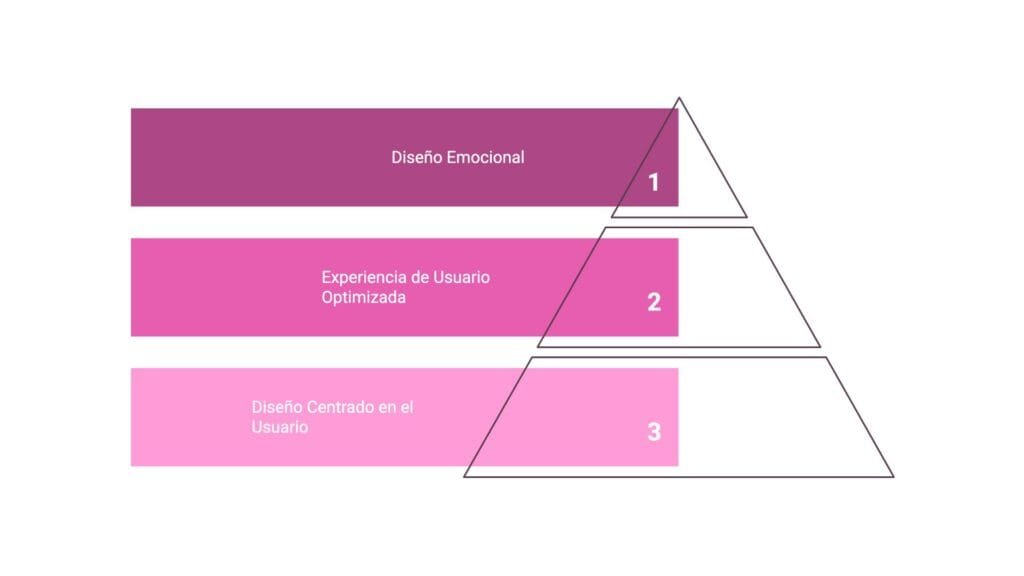
Conversion-Centered Design Pyramid
User-centered design
The user-centered design puts your audience's needs and behaviors at the center of every decision you make. design. This means:
- Investigate deeply your target audience
- Create detailed user personas
- Mapping the customer journey complete
- Prioritizing usability over visual complexity
2. Optimized user experience (UX)
The user experience determines whether a visitor stays on your site or leaves within seconds. A UX/UI design must:
- Reducing friction at each contact point
- Provide intuitive navigation
- Ensure fast loading times
- Offer relevant and easy-to-consume content
3. Emotional design that connects
The emotional design leverages the psychology of color, typography and imagery to generate specific emotional responses. This approach:
- Builds trust and credibility
- Generates emotional connection with the brand
- Influences purchasing decisions
- Differentiate your brand from the competition

Essential elements of functional design
Clear information architecture
A functional design starts with a well-structured information architecture. This includes:
Effective visual hierarchyUse sizes, colors and spacing to guide the user's attention to the most important elements.
Intuitive navigationCreate menus and navigation systems that are predictable and user-friendly, especially in the responsive design.
Scannable contentOrganize information in digestible blocks with clear headings, bulleted lists and short paragraphs.
Optimization for mobile devices
The responsive design is no longer optional. With more than 60% of web traffic from mobile devicesyour site should:
- Adapt perfectly to any screen size
- Maintain full functionality on touch devices
- Fast loading even with slow connections
- Deliver a consistent experience across all devices

Consistent branding and visual identity
Building a strong brand identity
Your visual identity should reflect your brand's values and personality in a consistent way. A brand identity effective includes:
Strategic color systemSelect color palettes that are not only attractive, but also communicate the right values and generate the desired emotions.
Purposeful typographyChoose fonts that enhance legibility while reinforcing the brand's personality.
Distinctive graphic elementsDevelop unique iconography, patterns and visual elements that make your brand memorable.
Integration of branding in web design
The branding is subtly integrated in every aspect of the web page design:
- Headers and footers that reinforce the visual identity
- Buttons and interactive elements with brand style
- Images and graphics that maintain visual consistency
- Micro-interactions that reflect the brand's personality

Advanced lead generation strategies
Effective lead design
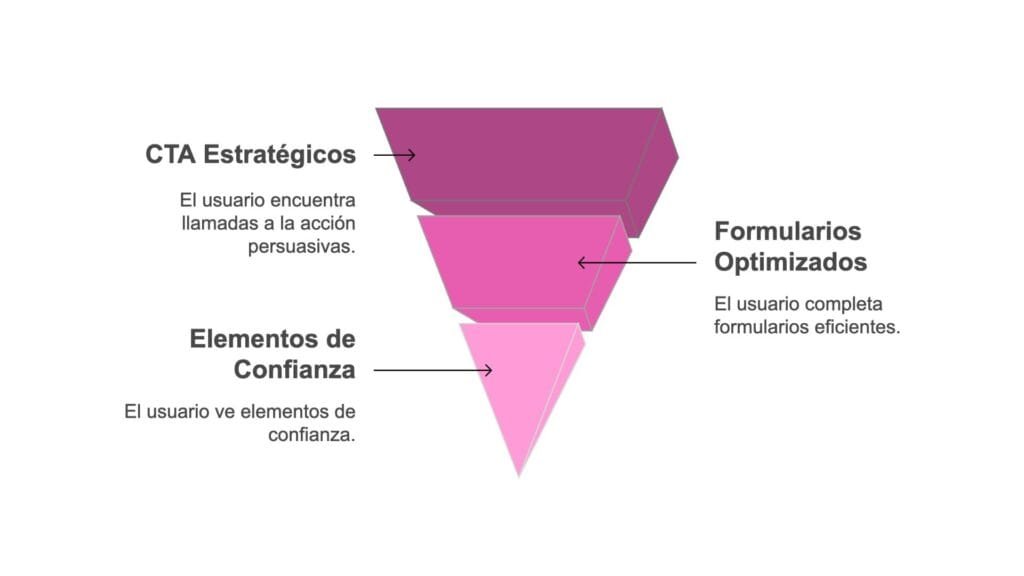
Lead Generation Funnel
The design for leads requires a strategic approach that combines user psychology with best conversion practices:
Strategic Calls to Action (CTAs)Positioning action buttons at key moments in the user journeyusing contrasting colors and persuasive text. The CTAs most effective use specific action verbs like "Download now", "Request demo" or "Get free consultation".
Optimized formsDesign forms that request only essential information, reducing friction and increasing conversion rates. Implement progressive forms that reveal additional fields only when necessary.
Elements of trustIncorporate testimonials, customer logos, certifications and warranties in strategic locations. Include SSL security indicators, trust seals and industry badges.
Landing pages that convert
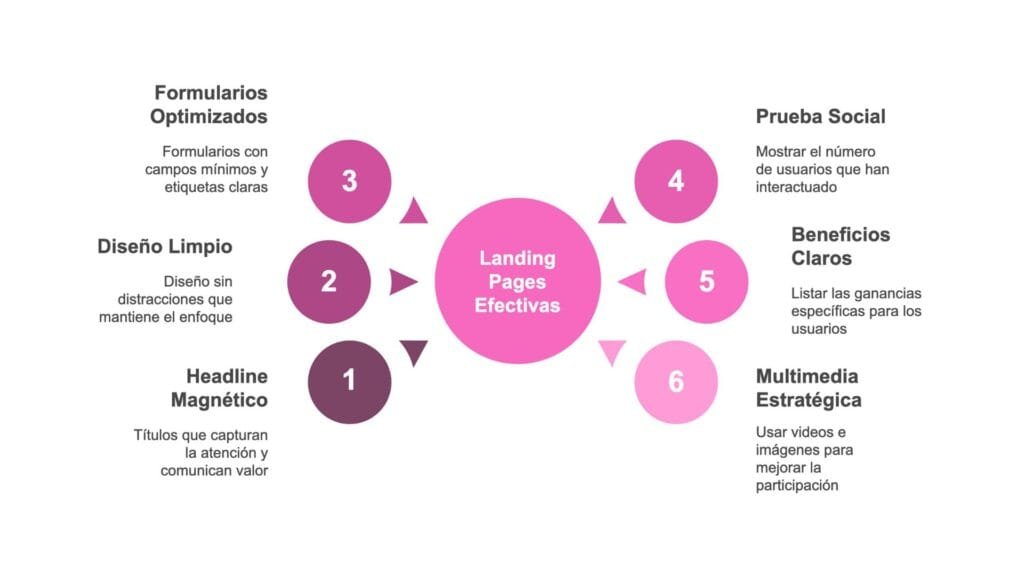
Elements of Effective Landing Pages
The landing pages are essential for the development of lead generation:
Magnetic headline: Create titles that immediately capture the attention of and communicate the unique value.
Clean design without distractionsEliminate navigation menus and elements that may divert attention from the main objective.
Optimized conversion formsUse minimum fields and clear labels.
Social proof and elements of urgencyShow how many people have downloaded the resource or have registered.
Clear benefitsList specifically what the user will gain by converting.
Strategic multimedia: Explanatory videos, product images or interactive demonstrations.
Innovative lead capture tools
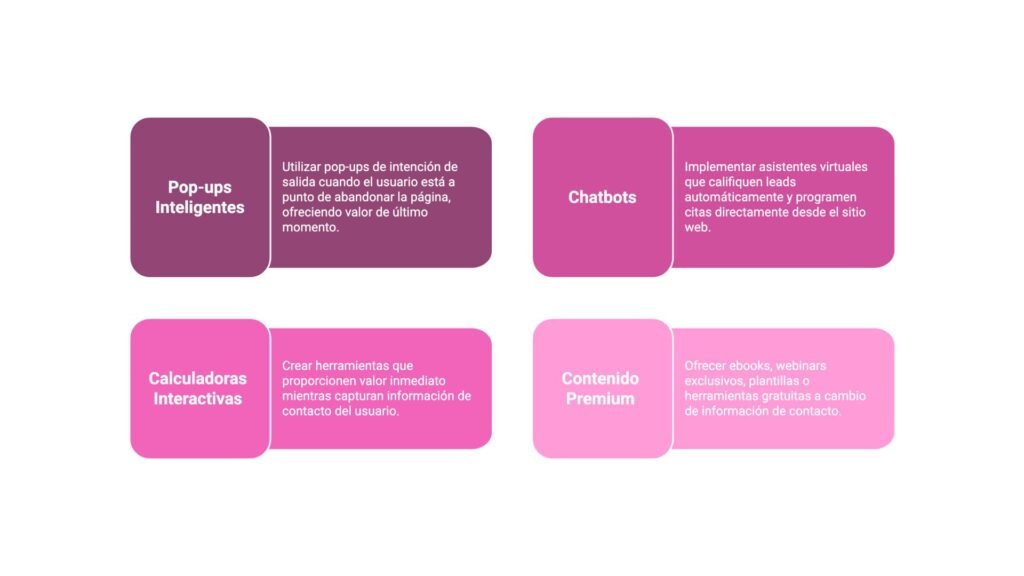
Lead Capture Tools
Intelligent pop-upsUse exit-intent pop-ups that appear just as the user is about to leave the page, offering last-minute value.
Conversational chatbots: Implement virtual assistants that automatically qualify leads and schedule appointments directly from the web site.
Interactive calculators: Create tools that provide immediate value while capturing contact information.
Premium contentOffer ebooks, exclusive webinars, templates or free tools in exchange for contact information.

Advanced Conversion Rate Optimization (CRO)
Proven CRO techniques
The conversion optimization is a continuous process that includes:
Systematic A/B TestingTest different versions of key elements such as headlines, buttons, colors and layouts to identify what works best. Implement multivariate tests to analyze multiple elements simultaneously.
Behavioral analysisUse tools such as heatmaps and session recordings to understand how users actually interact with your site. Tools such as Hotjar, Crazy Egg or Microsoft Clarity provide valuable insights on navigation patterns.
Speed optimization: Ensure that your site load in less than 3 secondsevery additional second can be reduce conversions up to 7%. Implement lazy loading, optimize images and use CDN to improve loading times.
Analysis of conversion funnelsIdentify exactly where users abandon the conversion process and optimize those critical points.
Dynamic customizationShow different content based on traffic source, geographic location, device or previous user behavior.
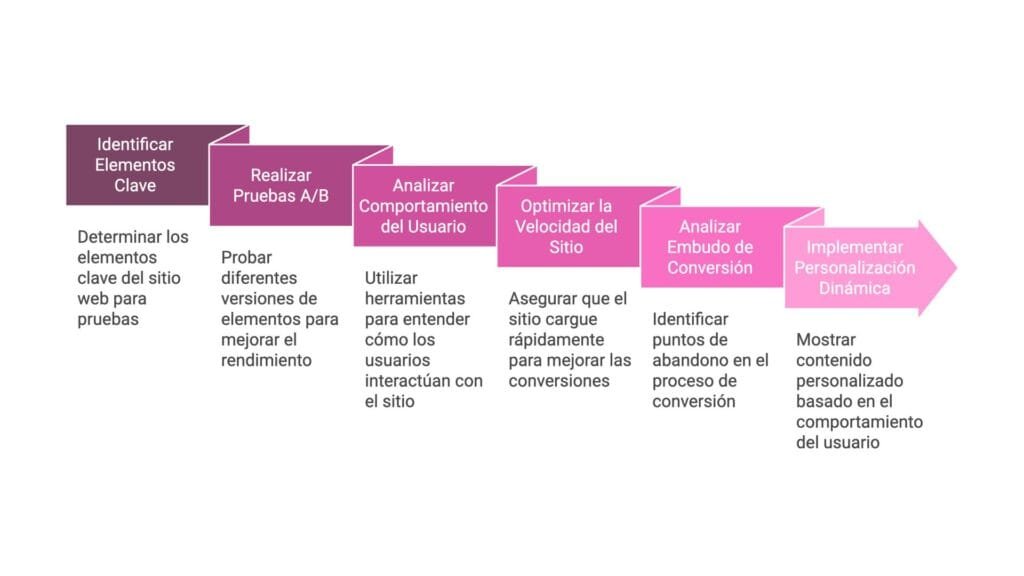
Conversion Optimization Process
Advanced psychological optimization
Principle of scarcityShow limited availability or limited time to create genuine urgency.
Dynamic social test: Show real-time activity like "5 people are viewing this product" or "123 people registered this week".
Reduction of cognitive frictionSimplify complex decisions through clear comparisons, personalized recommendations and elimination of unnecessary choices.
Anchoring and framing: Present prices and offers in such a way that the perceived value is maximized.
Persuasion techniques applied to design
Reciprocity: Offering free value before requesting information contact us.
AuthorityShow credentials, certifications, years of experience and industry recognitions.
ConsistencyCreate a logical path that leads naturally to conversion.
SympathyUse images of real people, authentic testimonials and a human tone of communication.
Advanced metrics to measure ROI
To evaluate the effectiveness of your professional web designIn addition, it is crucial to monitor metrics that go beyond the basic ones:
Advanced conversion metrics:
- Micro-conversionsNewsletter signups, resource downloads, time spent on specific pages.
- Macro-conversionsSales, qualified leads, demos requested.
- Customer Lifetime Value (CLV)Impact of the design in withholding and total value.
- Attribution modelingUnderstand how different touchpoints contribute to conversions.
User experience metrics:
- Core Web VitalsLCP, FID, CLS to measure the performance
- Task completion ratePercentage of users completing specific actions.
- Time to valueTime it takes a user to get value from the site.
- Net Promoter Score (NPS)Satisfaction and likelihood of recommendation.
Engagement metrics:
- Session quality scoreCombination of time, page views and interactions.
- Rate of returning visitorsPercentage of returning users.
- Social exchange rateFrequency with which the content is shared.
- Email subscription feeSite effectiveness to build audience.
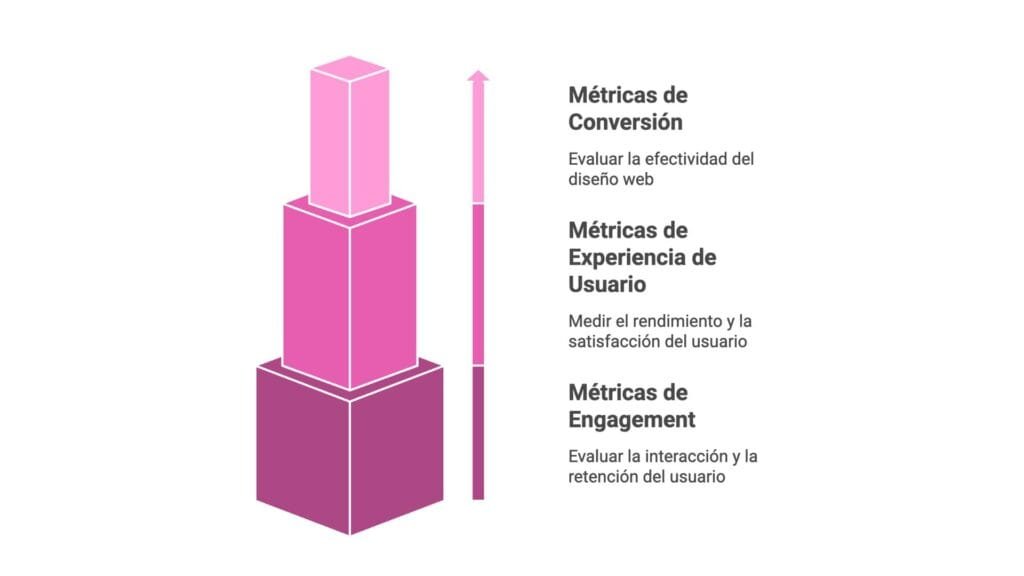
Hierarchy of ROI Metrics
Specialized analytics tools
Google Analytics 4Advanced configuration with custom events, conversion goals and audience segmentation.
Adobe AnalyticsFor business analytics with advanced segmentation and reporting capabilities.
MixpanelEvent tracking: Detailed event tracking to understand specific user behaviors.
AmplitudeProduct analysis to understand complex user journeys and feature adoption.
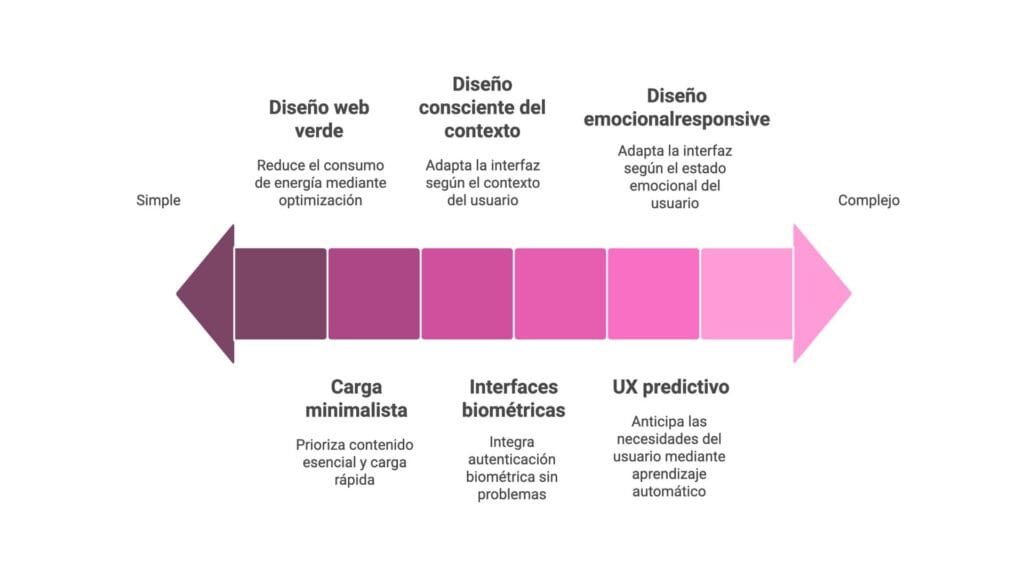
Web Design Spectrum From Simplicity to Complexity
Web design trends
Web3 and decentralized design
Wallet integrationInterfaces that simplify the connection with digital wallets, by means of UX design intuitive and eliminates technical complexity.
NFT galleries3D visual experiences and augmented reality for exhibition of digital collections, integrating marketplace functionalities with emotional design which raises the perceived value.
DAO interfaces: Decentralized voting and governance systems that translate complex blockchain processes into. user experiences accessible and transparent.
Sustainability in web design
Green web design: Implementation of functional design that reduce energy consumption by up to 70% through code optimization, intelligent asset compression and sustainable hosting architecture.
Sustainable UX and behavioral design: User-centered design that promotes eco-friendly behaviors through subtle nudging, green gamification and environmental education integrated naturally into the experience.
Minimalist loading and efficient transfer: Strategies for responsive design that prioritize essential content, implement intelligent lazy loading and reduce data transfer without compromising functionality or conversion.
Biometric authentication
Intuitive biometric interfaces: UX/UI Design that seamlessly integrates fingerprint authentication, facial recognition and voice authentication, eliminating traditional passwords while maintaining maximum security.
Privacy-first design: Architecture of user experience which implements zero-knowledge protocols, end-to-end encryption and full transparency on biometric data usage, building trust through transparent design.
Adaptive interfaces with contextual intelligence
Context-aware design: Adaptive systems visual identityThe user's location, content and functionality based on GPS location, time of day, device type, weather conditions and user-specific context of use.
Predictive UX with machine learning: Interfaces that anticipate future user needs analyzing historical patterns, browsing behavior and contextual cues to proactively personalize the experience.
Emotional design responsiveTechnology that detects the user's emotional state through voice analysis, facial recognition, typing patterns and mouse movement to adapt colors, typography and content in real time.

The importance of SEO analysis in design
A professional web design that really generate leads not only must it be visually appealing, but it must be built from the ground up with a focus on SEO, UX/UI and conversion optimization (CRO). If the design is not aligned with technical and strategic best practices, it is very difficult to attract qualified traffic or convert visitors into customers.
Today more than ever, the user-centered designThe structure, speed and quality of the content are factors that have a direct impact on the search engine positioning and the lead generation.

Technical SEO integration
A good SEO website analysis should be the first step in any project of web page design. The technical aspects are the basis for the search engines can understand, index and rank your site effectively:
HTML5 web page structure: Using semantic tags such as
Image optimization: Images must be properly compressed and accompanied by descriptive alt attributes. This not only improves technical performance and accessibility, but also has an impact on the conversion optimization and the responsive designensuring that the site works well on all devices.
Schema Markup and structured data: Implement Schema Markup enriches the results of the results in the search enginesThe site will display ratings, frequently asked questions, product or service information, thus increasing visibility and click-throughs.
Performance and loading speed: Speed is a key factor in the user experience and the SEO. A functional design must be light, fast and efficient, aspects that have a direct impact on the lead generation.
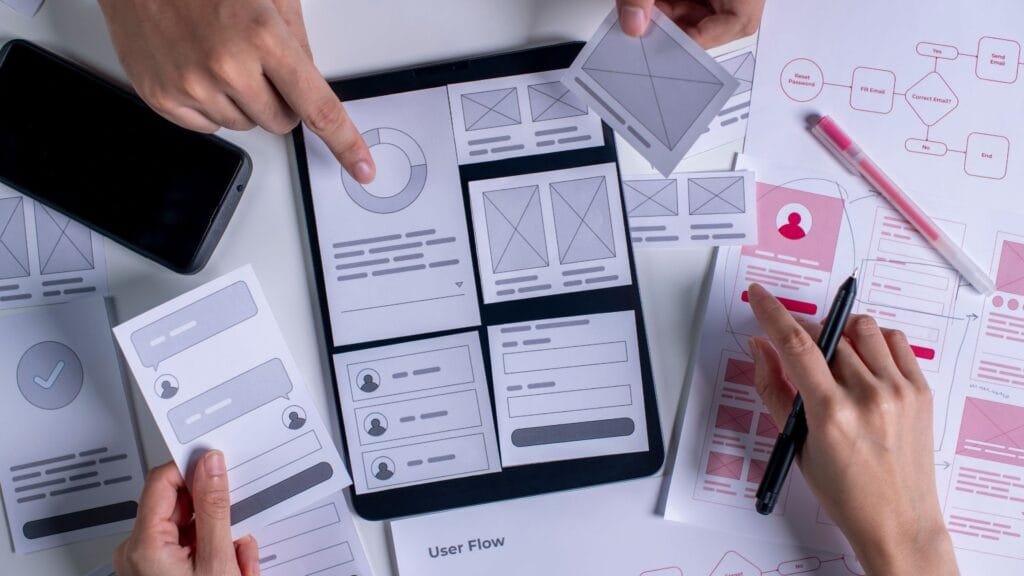
SEO and user experience
The search algorithms current prioritize sites that combine user-centered designtechnical performance and relevant content. This means that a good UX designThe conversion focus is as important as aesthetics:
Core Web Vitals optimized: Google evaluates metrics such as visual stability, interactivity and load time, all elements that must be taken care of in a responsive design and professional.
Clear navigation and logical structure: The web page design should offer a consistent and easy-to-navigate architecture, which decreases the bounce rate and facilitates the conversion optimization (CRO).
Emotional and functional design: The emotional connection with the user through the emotional designThe clear and efficient interface, coupled with a clear and efficient interface, boosts confidence and facilitates decision making.
High quality content and solid branding: The information must be aligned with the visual identity and the brand identitytransmitting coherence, credibility and generating greater impact.
Mobile-first design: More than 60% of users are accessing from mobile devices, so a responsive designfast and focused on the user experienceis essential for attracting traffic and generate leads.

Implementing your web design strategy
A web page design, that impacts and converts, requires a structured process, aligned with the business and the expectations of the target audience. This process integrates aspects such as UX/UI, branding, SEO and conversion optimizationto ensure tangible results.
Phases of the design process
A professional project of design and development of web pages should consider the following steps in order to maximize the lead generation:
- Research and strategy: The first step is to understand the market, competition and audience profile. We also conduct a SEO website analysis to detect opportunities, relevant keywords and technical aspects to optimize from the beginning.
- Information architecture: The logical structure of the site is defined, with a HTML5 web page structure clear, intuitive menus and navigational paths that simplify exploration and enhance the user experience.
- Visual design, brand identity and UX/UI: Here we work on the visual identitycombining emotional design and functional designdeveloping attractive, coherent interfaces, focused on the conversion optimization.
- Technical development and testing: The implementation must follow the following standards professional web designconsidering accessibility, performance, responsive designcompatibility and security. Testing ensures that everything works before launch.
- Launching and continuous optimization: Once online, key metrics such as traffic, conversion rate and positioning are monitored. The data allows constant adjustments to be made to optimize the lead generation.

Achieving a Successful Web Design Strategy
Maintenance and continuous evolution
A web design successful does not end with the launch. To remain competitive and continue to generate results, it is required:
Content updates and SEO optimization: Generate quality content aligned to the brand identity and optimized for search engines is key to maintaining relevance.
Metrics and behavior monitoring: Analyzing traffic, clicks and conversions allows you to identify opportunities for improvement and to adjust the design for leads.
Technological adaptation and trends: Digital evolution is constant. A site must update its user-centered designintegrating new technologies and maintaining its responsive design and functional, aligned to current requirements.

Your website can be your best salesperson 24/7
The web design effective combines art and science, aesthetics and functionality, creativity and rigorous data analysis. The first digital impression can determine a business' successinvesting in a professional web design optimized for conversion is not only advisable: it is absolutely critical for business survival.
The strategic integration of the principles of UX designadvanced techniques of branding and proven methodologies of CRO creates websites that transcend the basic function of "displaying information". These sites become sales tools sophisticated software that work tirelessly for your business, generating qualified leads and conversions.
From the most technical web structure to the most subtle micro-interactions that generate specific emotions, each element must be meticulously designed with the end user and business objectives as the top priority. It's not about following trends for fashion, but about implement strategies tested that generate measurable results.
The companies that are dominating the digital market understand that their web site is not an expense, but the more profitable investment they can do. A user-centered design well executed not only improves the user experiencebut translates directly into:
- Average increase in conversion rates
- Reduced cost of customer acquisition
- Increased time spent on the site
- Improves the SEO positioning organic
- Growth in lead generation qualified

The opportunity is here, but it won't be forever.
The digital market is constantly evolving, and companies that fail to adapt will become obsolete. While your competitors continue to see their web site as a "static digital business card," you can be taking advantage of the latest digital business card techniques. conversion optimization and emotional design to capture a disproportionate share of the market.
The trends we have explored, from AI in UX design to augmented reality interfaces are not futuristic: they are available today. The companies that implement them first will have a significant competitive advantage which will be increasingly difficult for latecomers to achieve.
The time to act is now
Don't let your competition take the lead while you keep postponing the optimization of your digital presence. Every day that passes with a web site represent potential customers who are choosing your competitor simply because their web design inspires more confidence and makes it easier for them to make decisions.
The web design that converts is not the product of chance or luck: it is the direct result of data-driven strategy, proven experience and impeccable professional execution.
Written by Barbara Cabrera/Marketing Analyst
Are you ready to transform your website into your company's most powerful growth tool?
Get a detailed proposal that combines UX design cutting-edge, branding strategic and conversion optimization scientifically proven. No more "pretty" websites that don't sell, it's time for a real conversion machine.
Your digital future starts with the decision you make today. Are you going to be a leader or a follower in your industry?




